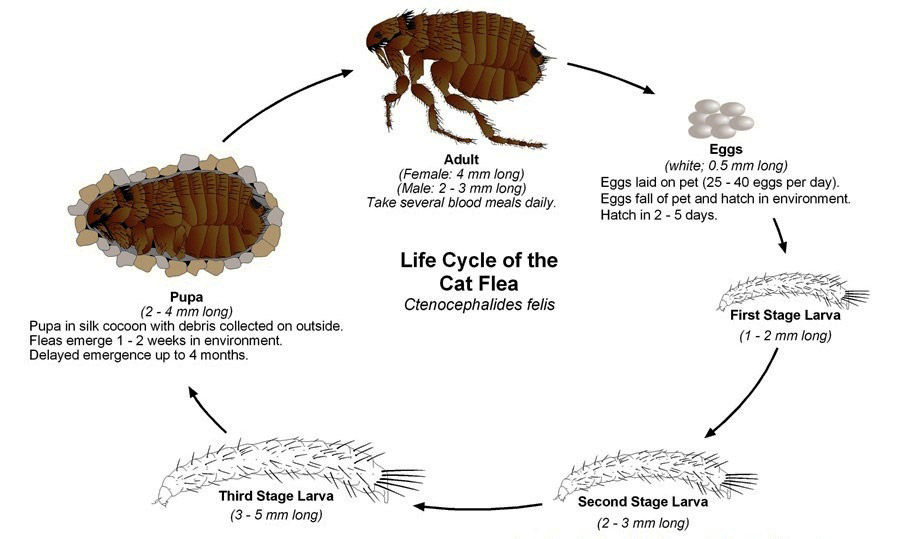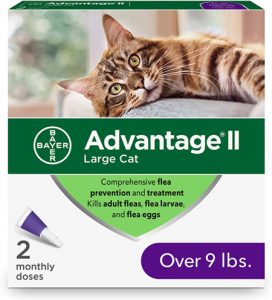Although we all have a general idea of an unassuming flea (for example, cartoon dogs scratching their ears), most of us actually know very little about them. This lack of knowledge can be especially dangerous for pet owners, who not only want to keep their beloved animals clean and healthy but also prevent any cross-infection or infections in the home.
And if you’re trying to get rid of a full-blown flea infection, knowing how they work is the key to getting rid of them forever. Read on to know flea facts that will help you defeat them!
How To Get Rid Of Flea Infestation
[amotables id=”277″ /]Do you see fleas?
Fleas are pretty tiny. How big are fleas? They usually have a length of 1 to 3 mm, and the females are larger than the males — while the female flea can be more than 2 mm, the average male flea can be less than 1 mm in length. Their tiny size makes it difficult to detect them, but they are visible to the naked eye, as you can see in the photos.
It is very difficult to notice individual fleas. More often than not, you will not notice that you have a flea problem until it is already infected, and at this point, you will be able to see a lot of fleas jumping around your pets or your home.
What Do Fleas Look Like?

Fleas are like tiny black specks with thin and flat bodies that allow them to move easily through your pet’s hair. But it makes no sense to describe them when the pictures speak a thousand words.
Where do fleas come from?
A lot of places. The most common source of fleas is your favorite pet. If your cat or dog is stuck outside, there are many potential places where they could pick up fleas. Fleas thrive in wet, shady and cool places, where there can be many places where your pet loves to hang out. Wildlife can also bring fleas into your yard, allowing your pet to easily pick them up – watch for raccoons, squirrels, rodents and wild cats since they can all carry fleas in your yard. As soon as the fleas are inside, they can feel at home almost everywhere, including on your pets, on the carpet or on furniture.
Where do fleas live?
Fleas live on bodies. It sounds like horror movies, but an adult, adult flea needs the host’s body to lay eggs – an adult flea can lay up to 50 eggs a day! Almost any warm-blooded creature will cope with the task – although the ideal owners for flea eggs, as a rule, are cats and dogs (due to their thicker fur). But do not worry. You see, flea eggs are not sticky, so after the female lays eggs on the host, small eggs fall on the carpet, on your pet’s bed, on your bed, and wherever they happen, fall out.
What do fleas eat?
There is no good way to express it: fleas feed on the host’s blood. Yes, fleas not only use the host body as an ideal breeding ground but also supply them with food. Small animals actually drink the blood of their pet to survive – some may even live 100 days without food! And when they drink, they drink a lot. A female flea consumes 15 times its own blood weight per day, which is not surprising given that she eats 50 of her children.
Do fleas bite humans?
Fleas are not the pickiest eaters, so yes; they will bite people for their blood. This is actually one of the common signs that you have blood on your hands because flea bites are very itchy and you tend to hold them around your legs and ankles.
Do fleas live on humans?
The whole question of whether people can get fleas is often asked. The answer is that yes, people can get fleas, although this is quite unlikely. There are more than 2,000 species of fleas, and only one species lives in the blood of people. In general, fleas prefer to live on fur-covered pets. The disadvantage is that if something happens to their owners, they can move on to the next best thing – you. However, fleas are much more difficult to live with us, not furry people, so you do not need to worry too much about it. Most likely, fleas will bite you, but in fact, will not live on you. It is also quite easy to get rid of fleas in humans.
Can fleas live in human hair?
If fleas love fur, can they not live in human hair? Yes, fleas can live in human hair, or simply use your hair as a temporary mobile home to travel until you get to another warm-blooded species whose blood it prefers, that is, dogs or cats.
Fleas Have a Strange Life Cycle
Flea is not born suddenly with its famous jumping legs and the thirst for your cat’s blood. The life cycle of fleas begins when an adult female receives blood meal – blood is necessary for flea breeding – and lays eggs on the host’s body. There are four stages of life for insects: an egg, a larva, a pupa, and a full-fledged adult. The stage of the egg cell and the larva is rather obvious, but in the pupae section, everything becomes interesting – and difficult for the person who is trying to get rid of them.
The pupa stage, in essence, is a kind of median line between the larva and the adult flea — the front jaws have formed, and the hind legs (used for jumping between owners) are not. Indeed, a flea at the pupal stage may remain in this state for several months in a row, until it finds a suitable host, or the environment around them becomes suitable for adult maturation. Worse, in the stage, fleas are wrapped in a silky cocoon that is resistant to insecticides and often rotates around the base of the fabric fibers they are on – it can be very difficult to kill or remove.
How long do fleas live?
The average life expectancy of fleas is usually 2 to 3 months. With plenty of food, a flea can last for about 100 days! The good news is that flea females cannot lay eggs until they receive their first blood.
How long can fleas live without a host?
As you already know, adult flea usually lasts only 2-3 months. But without a host, they will not last long. They are most vulnerable when a flea comes out of its pupa since it has only one week to find bloody food – otherwise, the owner – otherwise it will die.
Getting rid of fleas can be pain
As a result of the life cycle indicated above, it can be particularly difficult to get rid of small suckers. Different methods of killing them are required for each part of the life cycle (for example, what you use for flea larvae is unlikely to kill the remaining fleas at the pupal stage). To completely eliminate the problem of fleas, your pet will need a multi-faceted treatment plan that kills eggs, larvae, pupae, and adult fleas.
How do fleas breed?
Fleas breed like crazy. It is believed that a female flea can lay more than 2,000 eggs during its lifetime (although, interestingly, it cannot do this until it receives its first blood). Keep in mind that the average life expectancy is about 3 months. Despite the fact that the eggs are laid at the owner, they often fall, which can lead to the spread of infection in the environment – read your home.
Even worse?
The fleas that you actually see, jumping and biting, are only a small part of the infection with fleas – flea eggs make up about 50 percent of the infection in the house, while flea larvae and pupae make up 45 percent of the infection with fleas. This means that adult fleas, which you actually see, make up only 5 percent of flea infection. This is probably one of the most disturbing flea facts on this list.
Fleas love to share a love
Fleas are historically known for spreading bubonic plague, and can also transmit many other diseases and health problems: mouse typhus to people, carry tapeworms, cause anemia in animals and, simply, cause very irritating itchy lumps around their bites.
Do fleas fly?
It’s easy to think that fleas can fly because they jump so high, they seem to fly. But no, fleas cannot fly. They are wingless and unable to fly. What they are ridiculously good at is jumping.
How far can a flea jump?
Fleas – Olympic jumpers in the world of insects, capable of jumping up to 7 inches (18 cm) vertically and up to 13 inches (33 cm) horizontally – this is about 100 times their own height and length, which resembles a person who can jump over 300 meters! That’s how they manage to switch hosts so easily (considering that, although they are insects, they have no wings). And the reason why when you are treating fleas is that you have to do it absolutely everywhere. Otherwise, they will just jump on you or your pet when you walk past the couch.
Can Fleas Kill Dogs Or Cats?
Fleas are not just annoying, itchy trouble – they can cause serious harm to pets. There were cases when fleas actually killed puppies and dogs that were already weak and vulnerable from other health problems. Fleas are also the main cause of skin diseases in domestic animals, which can cause a wide range of problems from simple itching to bedsores.
To top it off, fleas can transmit a tapeworm to dogs and cats, and if your pet is allergic to flea bites – well, one bite can cause terrible reactions. Make sure that you take the steps necessary to prevent fleas, and regularly inspect their fur for any signs. The most common sign of a flea infection is itching in the area of their bites (although the larvae and some diseases transmitted by fleas can also cause skin irritation) – if your cat or dog has recently been scratching itself more than you expect, then you may already have a problem.
Fleas have adapted to survive
Despite the fact that they are small – sometimes almost undetectable – fleas have hardy little shells that make it difficult to crush them. In addition, they have adapted to the harsh environmental conditions, which means that no one is immune to the threat. To cheer you up here is one of the happiest facts about fleas: they can be tough, but they still need to eat. If a newly grown flea does not find a suitable host or does not receive blood food within a week, they are likely to die.
Close any unwanted holes
Fleas are much easier to prevent than to eliminate, so if you have pets or a potential rodent situation, start controlling fleas before you see fleas. In addition to domestic animals, one of the other main sources of contamination at home are foreign bodies, such as rodents entering the house, or cracks in the floor, which provide ideal places for hatching eggs. Therefore, seal any cracks, holes or crevices in walls, doors, windows, flooring, etc. This will help keep things like infected rodents and reduce your chances of infection.








